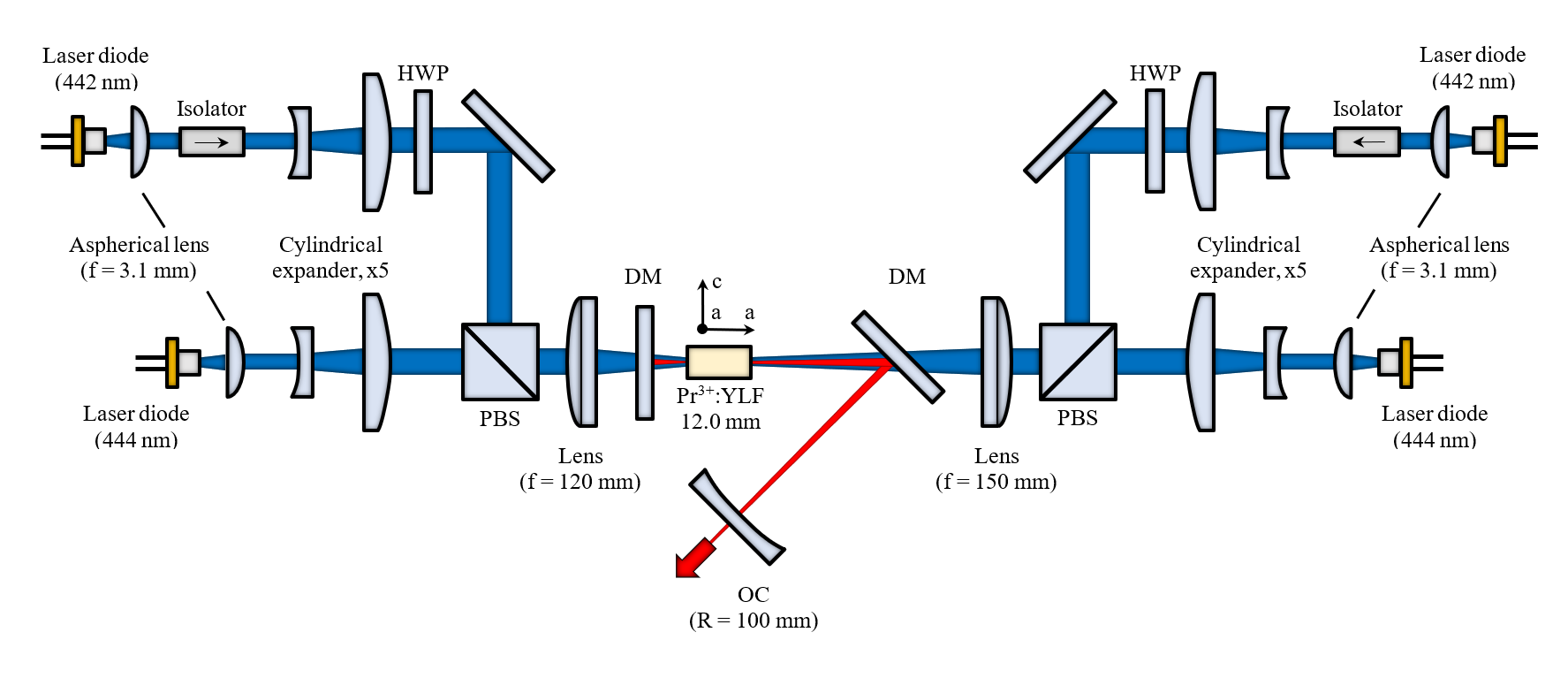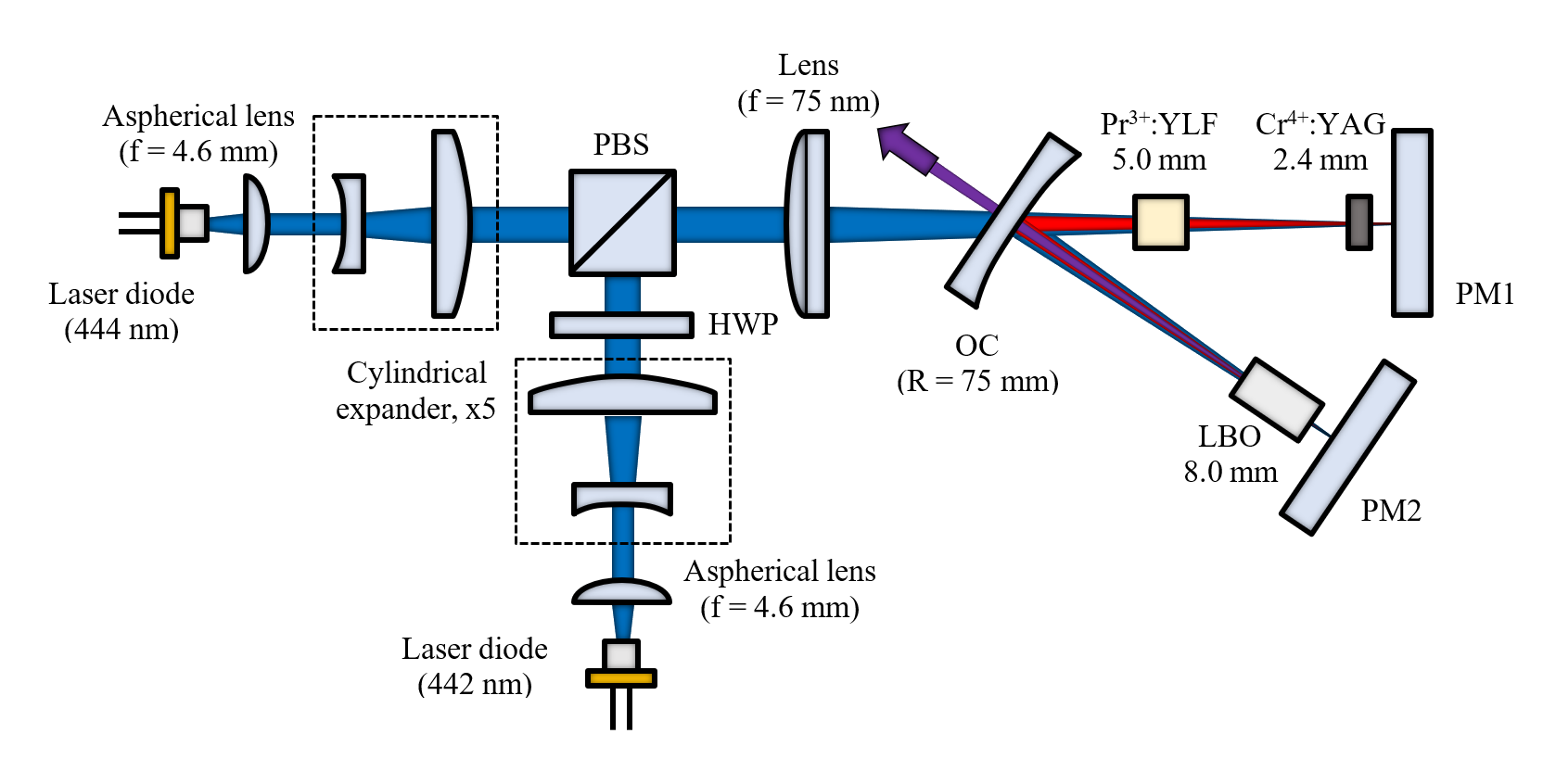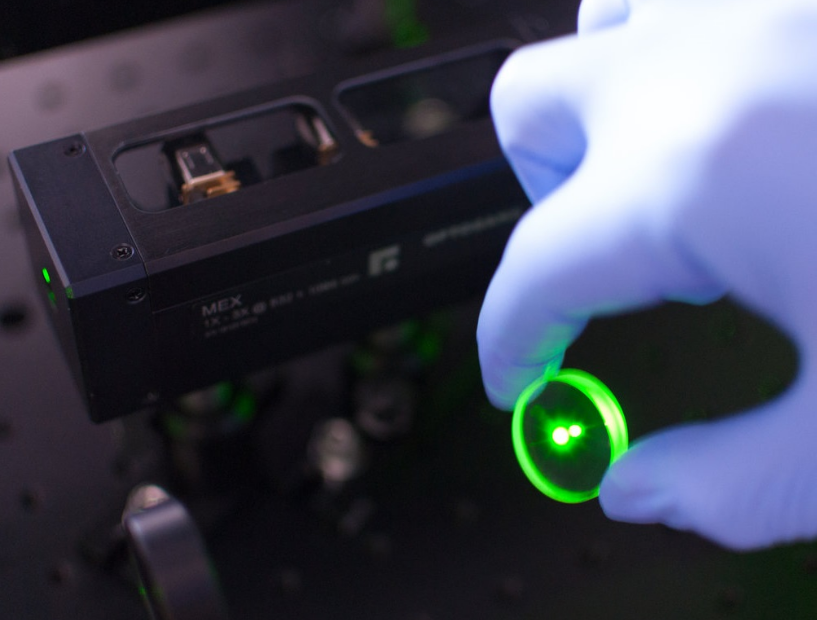Diode-pumped visible and UV Pr:YLF laser
Expected lasing parameters in the visible range:
- CW output power up to 6.7 W at the wavelength of 640 nm with slope efficiency up to 45%
- CW output power up to 3.7 W at the wavelength of 607 nm with slope efficiency up to 30%.
Expected lasing parameters in UV range:
- CW output power up to 481 mW at the wavelength of 261.3 nm with optical-to-optical efficiency of 26.1%
- Q-switched pulses with energy of 1.54 μJ, duration of 50 ns, repetition rate of 50 kHz at the wavelength of 320 nm
Pr:YLF laser application examples
- Biophotonic techniques (fluorescence microscopy and cytometry)
- Industrial applications (defect detection in semiconductor manufacturing, lithographic techniques, as well as material processing).
1.1. High power CW visible Pr:YLF laser
Diode-pumped CW visible Pr:YLF laser setup is based on H. Tanaka et al. article [1]. 4Lasers provide all the necessary optical components according to the previously mentioned article in order to assemble the Pr:YLF laser. The principal scheme of the laser setup is presented in Fig. 1.

Figure 1. Laser setup of high power CW Pr:YLF laser
As a pump source four single-emitter laser diodes, each emitting a maximum output power of 5 W in the central wavelength of 442 nm and 444 nm are used. It should be noted here that for a good spectral overlap of the LD emission spectrum and the crystal absorption spectrum the stabilization of LD temperature by Peltier modules should be applied.
Since the LD emitter has a rectangular stripe shape, each beam coming from the LD is extended along its slow axis by a factor of five using a cylindrical lens pair (f = −20 mm and 100 mm) in order to improve the mode-matching efficiency with the astigmatism-free cavity mode. Expanded beams are then combined at the polarizing beam splitters and focused by spherical lenses (f = 120 mm and 150 mm) into the laser crystal.
The laser resonator consists of three mirrors: two plane dichroic mirrors (DM) and an output coupler (OC) with a radius of curvature of 100 mm. The DMs must have a high reflectivity (HR > 99.5%) for 520 – 650 nm and a high transmission (HT > 98%) for 430 – 450 nm. The OC with a transmission of 5.2% is used for the laser operating at the wavelength of 640 nm. For the 607 nm laser operation an OC with a transmission of 10.8% at 607 nm and T > 90% at 640 nm is used. The cavity length should be optimized in order to obtain the maximum output power (lcav ~ 72 mm). As an active element (AE) the 5 mm diameter and 12 mm length AR coated (for both pump and laser wavelengths) rod cut perpendicular to a axis from 0.3 at.% Pr3+:YLF crystal is used. Water cooling of the gain medium is recommended.
Note that every optical element can be customized according to customers request.
Expected lasing parameters
4Lasers does not take any responsibility if the achieved lasing output parameters are not as described in the [1] article. Maximum output power at a maximum absorbed pump power of 15 W was 6.7 W and 3.7 W at 640 nm and 607 nm, respectively. The slope efficiency with respect to the absorbed pump power was calculated to be 45.5% and 30.0% at 640 nm and 607 nm, respectively.

1.2. CW UV Pr:YLF laser
Laser setup description
Diode-pumped CW UV Pr:YLF laser setup is based on T. Gun et al. article [2]. 4Lasers provide all the necessary optical components according to the previously mentioned article in order to assemble the Pr:YLF laser. The principal scheme of the laser setup is presented in Fig. 2.

Figure 2. Laser setup of CW UV Pr:YLF laser
As a pump source two InGaN laser diodes with a maximum output power of about 1 W each are used. A folded Z-type cavity enables pumping from two sides and provide optimal beam waists both in the gain medium (Pr3+:LiYF4 laser crystal with a dopant concentration of 0.5 at.% with the length of 2.9 mm) and in the nonlinear crystal (BBO crystal with the length of 5 mm). According to the reference article [2], the experimental results were achieved with beam waist radii inside the laser and nonlinear crystals of 50 µm and 53 µm, respectively. Beam collimation and shaping of the LD radiation are performed by using a spherical lens with a focal length of 4.5 mm as well as an anamorphic cylindrical lens pair. The lenses L1,2 of 40 mm focal length should be used in order to focus the pump beams into the laser crystal.
The folded Z-type cavity consists of three plane mirrors (M1, M2, M4) and a curved mirror M3 with a radius of curvature of 50 mm. The two input couplers M1 and M2 are AR coated in the range of 440 ± 40 nm and HR coated (R > 99.8%) in the range of 520 ± 20 nm. The mirror M4 is HR coated for 520 ± 20 nm and 260 ± 10 nm wavelengths. The BBO crystal, (type I phase matching Ѳ = 48.9º, γ = 0º) AR coated at 520 nm is placed in the beam waist located near M4. Most of the generated UV radiation is coupled out through the curved mirror M3 with transmission coefficients T520 nm = 0.02% and T260 nm = 91%. It should be noted that the mirrors M1 - M4 have a total transmission ~ 0.06% at the fundamental wavelength.
Note that every optical element can be customized according to customers' request.
Expected lasing parameters
4Lasers does not take any responsibility if the achieved lasing output parameters are not as described in the [2] article. Maximum output power of 481 mW at 261.3 nm can be achieved at the absorbed pump power of nearly 1.3 W. An optical-to-optical efficiency of 26.1% with respect to the total pump power can be expected.
1.3. Q-switch UV Pr:YLF laser
Laser setup description
Diode-pumped Q-switch UV Pr:YLF laser setup is based on H. Tanaka et al. article [3]. 4Lasers provide all the necessary optical components according to the previously mentioned article in order to assemble the Pr:YLF laser. The experimental setup is presented in Fig. 3.

Figure 3. Laser setup of Q-switch UV Pr:YLF laser
The laser is pumped by polarization-combined InGaN blue diode lasers whose output power is 3.5 W. The diode pumps are collimated by an aspherical lens (f = 4.6 mm) and expanded five times by the cylindrical lens pair (f = −20 and 100 mm) along the slow axis to shape a symmetric focal spot. The pump beams are combined at the polarization beam splitter (PBS) and focused into the gain medium (Pr3+:YLF crystal 5.0 mm long, cut perpendicular to the a-axis with a doping concentration of 0.5 at.%) through a spherical lens (f = 75 mm). All lenses are AR coated in the range of 440 ± 40 nm. It should be noted that the expected lasing parameters can be obtained with a spot radius ∼ 32 × 48 μm. The crystal is recommended to be mounted on a water-cooled copper holder, and the temperature of the circulating water should be maintained at near 16°C.
The V-fold cavity consists of two plane mirrors and a concave output coupler with a radius of curvature of 75 mm and a transmission of 80% at 320 nm. The PM2 end mirror has a high reflectivity both at 640 and 320 nm. As a saturable absorber, 2.4 mm long Cr4+:YAG with an initial transmission of 91.7% should be used. To convert the 640 nm fundamental wave into a 320 nm second harmonic wave, an 8.0 mm long LiB3O5 crystal (Type I phase matching θ = 90°, φ = 53.5°) is recommended to be used. No additional cooling is necessary for Cr4+:YAG and LiB3O5 crystals.
Note that every optical element can be customized according to customers' request.

Expected lasing parameters
4Lasers does not take any responsibility if the achieved lasing output parameters are not as described in the [3] article. By employing two 3.5 W high-power blue InGaN laser diodes Q-switched pulses with the pulse energy of 1.54 μJ and duration of 50 ns can be obtained at a repetition rate of 50 kHz.
References
[1] H. Tanaka, S. Fujita, and F. Kannari «High-power visibly emitting Pr3+:YLF laser end-pumped by single-emitter or fiber-coupled GaN blue laser diodes,» Applied Optics vol. 57, no. 21, pp. 5923–5928, 2018.
[2] T. Gun, P. Metz, and G. Huber «Efficient continuous-wave deep ultraviolet Pr3+:LiYF4 laser at 261.3nm,» Appl. Phys. Lett. vol. 99, 181103, 2011.
[3] H. Tanaka, R. Kariyama, K. Iijima, and F. Kannari «50-kHz, 50-ns UV pulse generation bydiode-pumped frequency doubling Pr3+:YLF Q-switch laser with a Cr4+:YAG saturable absorber,» Applied Optics vol. 55, no. 23, pp. 6193–6198, 2016.

SKU: 18787

SKU: 18788


